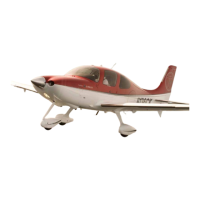10-4 P/N 13772-003
Section 10 Cirrus Design
Safety Information SR22T
Cirrus Airframe Parachute System (CAPS)
The Cirrus Airframe Parachute System (CAPS) is designed to lower
the aircraft and its passengers to the ground in the event of a life-
threatening emergency. However, because CAPS deployment is
expected to result in damage to the airframe and, depending upon
adverse external factors such as high deployment speed, low altitude,
rough terrain or high wind conditions, may result in severe injury or
death to the aircraft occupants, its use should not be taken lightly.
Instead, possible CAPS activation scenarios should be well thought
out and mentally practiced by every pilot.
The following discussion is meant to guide your thinking about CAPS
activation. It is intended to be informative, not directive. It is the
responsibility of you, the pilot, to determine when and how the CAPS
will be used.
Deployment Scenarios
This section describes possible scenarios in which the activation of the
CAPS might be appropriate. This list is not intended to be exclusive,
but merely illustrative of the type of circumstances when CAPS
deployment could be the only means of saving the occupants of the
aircraft.
Mid-Air Collision
A mid-air collision may render the airplane un-flyable by damaging the
control system or primary structure. If a mid-air collision occurs,
immediately determine if the airplane is controllable and structurally
capable of continued safe flight and landing. If it is not, CAPS
activation should be considered.
Structural Failure
Structural failure may result from many situations, such as:
encountering severe gusts at speeds above the airplane’s structural
cruising speed, inadvertent full control movements above the
airplane’s maneuvering speed, or exceeding the design load factor
while maneuvering. If a structural failure occurs, immediately
determine if the airplane is controllable and structurally capable of
continued safe flight and landing. If it is not, CAPS activation should be
considered.
Original Issue

